Regional Background
During the time of the British Empire in Asia, the region was known as the Indian sub-continent comprising of today’s India, Pakistan, Bangladesh, Sri Lanka, Afghanistan, Nepal and Bhutan. At that Afghanistan for some remained on the periphery of the Indian sub-continent. However, if we go by the definition of the South Asia Association for Regional Cooperation (SAARC), then Afghanistan and the Maldives are part of contemporary South Asia. And that is how South Asia is demarcated, comprising of eight SAARC member states. Nevertheless, the definition of South Asia is open to debates on historical, cultural, political, religious and ethnics grounds.
The region faces numerous bilateral and intra-state conflicts and that all in addition to various human security threats of poverty, food security and so on. In the end, both structural and non-structural forms of violence are making people suffer in the region, in particular the victims are women and children.
The region is home to one-fifth of the humanity but sadly is also home to almost half of the world’s poorest of the poor. Due to financial constraints it is hard for most of the countries in the region to provide basic needs to its entire people therefore tens of thousands of children stay out of schools and are found either working to make their livings or as beggars on streets of major metropolitans in South Asia.








